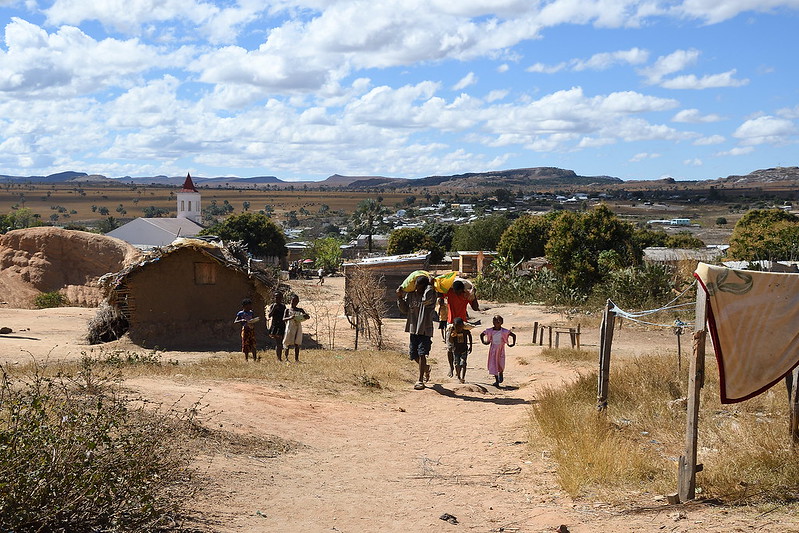Ilakaka — In southwestern Madagascar, a small town is known as Ilakaka, along with National Route 7, the main road that links the country's capital, Antananarivo, with the port of Toliara. Twenty years ago, Ilakaka practically exist, with just 40 inhabitants. In less than ten years, its population soared more than 100,000, as people from all over Madagascar began arriving at sapphire mines of Ilakaka in search of sapphires.
 |
| Mines in Madagascar |
Madagascar Sapphire
In the late 1990s, the Sapphire was discovered in southern Madagascar. Until then, Ilakaka was little more than a truck stop with a small group of shacks and a few dozen residents. When the news of the sapphire discovery was made, Ilakaka was filled with tens of thousands of inhabitants, Gems of Madagascar, who turned a quiet village into the sapphire capital of the world, supplying almost 50% of the total sapphires on the planet.
Despite the economic boom, Ilakaka never developed beyond a slum where poor families lived in small wooden houses. Most of the workers came to town with the intention of getting rich and later returning to their places of origin, although in the end, they become poor labor of Madagascar mining. Malagasy workers ended up being exploited by Thais and Sri Lankan merchants. There are currently a large number of illegal miners operating in Ilakaka who smuggle large quantities of jewelry out of the country. There are few laws that are enforced, despite the presence of a police force.
First Image / Source
 |
| Mining in Madagascar |
Image / Source
Madagascar mining
Despite the economic boom, Ilakaka never really developed. A few gem-buying shops and some commerce have sprung up on both sides of the road, and a growing slum around it has sprung up, where poor families live in small mud houses with thatched roofs and some made of wood.
Individual illegal miners mixed with large-scale operations, all operating under little or no regulation, have turned the region into a typical lawless old west, and one of the most violent places in the small country. Mining rights are owned by large groups. Conflicts between mining groups, miners, traders, and local villagers are constant and result in a lot of violence. Large quantities of precious stones are smuggled out of the country daily. Few people make much money from it, while more than 90 percent of the population lives on less than $2 a day. A single stone can sell for hundreds of thousands of dollars.
 |
| Madagascar mining |
Image / Source
In the years that followed, the open-air sapphire fields were being depleted, leaving only the miners to work in deep holes, and often using children to descend into these holes that can reach a depth of thirty meters. Mining is also done by entire families, and according to a survey, of the 21,000 children who live in the region, 19,000 belong to families that work in the extraction of sapphires. In an organized mine, more than 200 workers dig daily for sapphires with picks and shovels, leaving a huge hole in a place like an inverted pyramid. When the sapphire vein runs out, the mine owner moves his workers to a new location. The mining area in Ilakaka is extensive, covering 4,000 square kilometers,
 |
| Gems in Madagascar |
Image / Source
Any variety of the mineral corundum that is not red in color is given the name sapphire (the red variety of corundum is ruby). It can be colorless, blue, purple, golden, or pink, among others. Colors are due to the presence of cobalt, chromium, titanium, or iron. Pure sapphire is transparent. Traces of iron and titanium give the bluish color. Pink, yellow, green, white, and multi-colored sapphires are often less valued than the blue variety of the same quality and size. However, the pink/orange sapphire, called Padparacha or Padparadja, is highly valuable. When color is not specified, the term sapphire refers to the blue variety.
The largest sapphire ever found was over 200 grams raw and was found in Ratnapura, Myanmar (formerly Burma). Of the cut gemstones, the largest of all is the “ Star of India ”, with 575 carats, which is in the American Museum of Natural History in New York. The “ Logan ” is 424 carats and is blue in color. The 330-carat “ Star of Asia ” is also in the United States at the Smithsonian Institution in Washington. The 135.8-carat “ Ruspoli ” sapphire is also famous.
In recent years, Ilakaka has fallen into difficult times, as all the sapphire fields of mining in Madagascar have been practically cleared, and the remaining miners often have to work deep holes of mines in Madagascar, going down to great depths and risking their lives every day.
 |
| Sapphire mining in Madagascar |
Image / Source
 |
| Sapphire mines Madagascar |
Image / Source
 |
| Madagascar Sapphire mines |
Image / Source
 |
| Madagascar Sapphire mining |
Image / Source
 |
| Madagascar mines |
Image / Source
 |
| Madagascar gem mines |
Image / Source
 |
| Gems of Madagascar |
Image / Source
 |
| Madagascar Sapphire |
Image / Source
 |
| Gemstones found in Madagascar |
Image / Source
 |
| Gemstone Madagascar |
Image / Source
Mines in Madagascar — Video
Sapphire mining in Madagascar — Google Map
 |
| Sapphire mines |
Image / Source

No comments:
Post a Comment